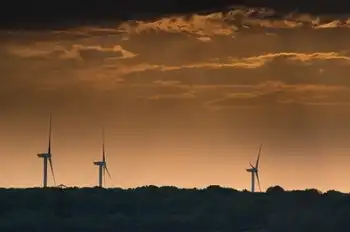Anschutz wind project advances amid grouse concerns
More than half of the company's Chokecherry and Sierra Madre project is proposed for land identified by the state as "core population area" in Carbon County. The state designated the areas as part of its strategy to stave off federal protections for the bird.
Power Company of Wyoming is an affiliate of Denver-based Anschutz Corp. Bill Miller, who directs The Anschutz Corp.'s natural resources division, said the company has completed about two-thirds of an environmental impact statement with the Bureau of Land Management.
The company hopes to begin construction in 2011 on the $4- to $6-billion project, which would cover about 154 square miles on the Anschutz-owned Overland Trail Cattle Company ranch. The ranch is comprised of private land mixed in a checkerboard with BLM and state lands.
"We're proceeding with our project just as we were before the sage grouse core areas were defined. We feel that there's a variety of methods that the core area issue can be dealt with," Miller said.
Wyoming is home to more than half of the nation's population of sage grouse, a chicken-sized, ground-dwelling bird. The U.S. Fish and Wildlife Service is reviewing the bird for possible listing as threatened or endangered under the Endangered Species Act. A decision is expected in February.
This summer, the Wyoming office of the U.S. Fish and Wildlife Service said it opposes construction of any wind turbines in core areas, prompting Wyoming state government to strengthen its stance against such development.
The wind industry responded that the state's position could have a chilling on wind energy development. A short time later, Horizon Wind Energy suspended development of the Simpson Ridge wind farm because it falls within core area boundaries.
Miller said Power Company of Wyoming is awaiting the federal listing decision while also studying ways to develop the project without causing a net loss to the sage grouse population. That includes mitigation strategies, such as improving alternative habitat areas.
"What we need to do, as an industry, and certainly as our company, is let's just wait until we get a decision and everybody needs to just calm down, in my opinion, and let this process work," Miller said. "Let's wait until the U.S. Fish and Wildlife Service makes their determination and we'll react to that accordingly."
Power Company of Wyoming is carefully studying the sage grouse on its own property, Miller said, so it will be ready to work under limitations imposed by the federal government or the state's core area strategy.
He said the company is also studying the boundaries of the state's core grouse areas to determine whether they're accurate on the Anschutz ranch.
"I think it's appropriate to assume we can modify the core habitat boundaries on our ranch and on our project simply based on the information that we can develop," Miller said.
Bob Budd, chairman of the state's Sage Grouse Implementation Team, said Gov. Dave Freudenathl's executive order establishing the core areas specified that their boundaries may be adjusted as more information becomes available. But he said it will be difficult for anyone to develop within the core areas.
"Certainly there's nothing wrong with applying creative thought to this, but unless you can invent birds, right now it's going to a pretty tough row to hoe to do anything in a core area," Budd said.
Power Company of Wyoming is betting on the chance that it will find a way to build turbines within the existing core area boundaries.
"If we have to work outside of the core area solely on the ranch, it probably will not happen," Miller said.
Related News

Hydro One deal to buy Avista receives U.S. antitrust clearance
TORONTO - Hydro One Ltd. says it has received antitrust clearance in the United States for its deal to acquire U.S. energy company Avista Corp.
The Ontario-based utility says the 30-day waiting period under the Hart-Scott-Rodino Antitrust Improvements Act expired Thursday night.
Hydro One announced the friendly deal to acquire Avista last summer in an agreement that valued the company at $6.7 billion.
The deal still requires several other approvals, including those from utility commissions in Washington, Idaho, Oregon, Montana and Alaska.
#google#
The U.S. Federal Communications Commission must also sign off on the transaction and clearance is required by the Committee on Foreign Investment…




